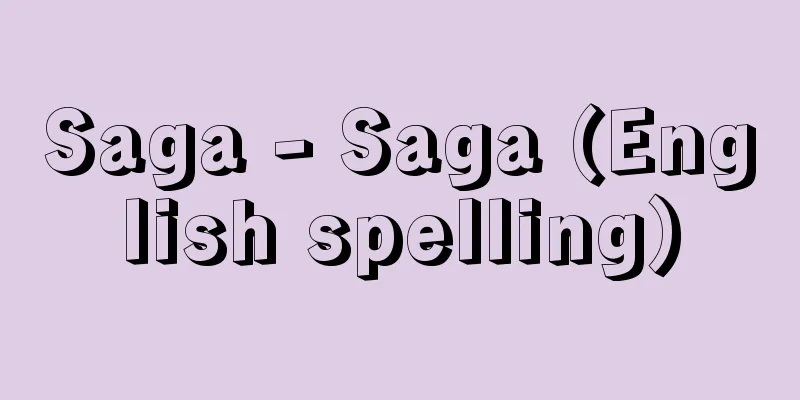Saga - Saga (English spelling)

|
Along with the Eddas and skaldic poems, these are stories written in Old Norse that remain in Iceland. Saga means "narration," "told events," or "tales." In contrast to the Eddas, which are a collection of myths and songs of heroic legends passed down among the North Germanic people, the sagas are written in powerful prose in a chronicle-like style, and describe the events before and after the colonization of Iceland (around 870-930), life in Iceland after the settlement, Viking activities overseas, and conflicts between chieftains of the same era. There are over a hundred sagas, both long and short, and there are various ways to classify them, such as by content or by era, but it is convenient to classify them into four categories, based on Jan de Vries's "History of Old Norse Literature": "religious and academic sagas," "royal sagas," "Icelandic sagas," and "legendary sagas." The "religious and scholarly sagas" include the Book of Colonization, the most accurate record of the colonization of Iceland, the Book of Icelanders, a brief history of Iceland by Ari Thorgilsson (1068-1148), the Christian Saga, which deals with the conversion to Christianity, and the Sturlungasaga, a history that describes the feuds between powerful families, including the Sturlung clan, at the end of the Icelandic Republic. The "royal sagas" are set outside Iceland and mainly cover the deeds of Norwegian kings. The largest of these is Heimskringla, a history of the Norwegian dynasty written by Snorri Sturlson. The prologue, Yngringasaga, explains the lineage of the Norwegian royal family from the Age of the Gods, and the following 16 sagas tell the life and reign of each king. It covers a period of about 300 years, from the reign of King Harald Fairhair in 860 to King Magnus Erlingsson in 1177, but it vividly depicts the truth of history and people, eliminating the exaggerations and inaccuracies of previous sacred tales. Other "royal sagas" include "Jörm's Vikings Saga," which describes the exploits of the Danish Vikings who made Jomsborg their base, "Eirik the Red's Saga" and "The Tale of the Greenlanders," which tell of the discoveries of North America and Greenland. The "Saga of the Icelanders" is a masterpiece of saga literature in terms of both quality and quantity. Of these, "Eyitr Skattrágrimsson's Saga" is a record of the turbulent events of the family over four generations, starting from the grandfather of the protagonist, who is considered the greatest hero and poet of the Middle Ages. Grettir's Saga tells the story of the silent, rough and quarrelsome Grettir, who is plagued by misfortune, is banished and then meets a gruesome death. The Laxer Saga depicts the obsession of a woman who married four times but was never able to be united with her beloved. Other sagas include the Eyre Saga, which revolves around a conflict between rival chieftains, and Njáll's Saga, a tale of friendship and revenge. These are known as the five great sagas, but there are many other masterpieces as well. The legendary sagas are those that deal with heroes and legendary figures in a rather satirical way, such as the Borsungasaga, which is based on the Nibelungen legend, and the Rörb-Krakisaga, which has a Danish hero as its protagonist. [Yukio Taniguchi] "Edda and Sagas by Yukio Taniguchi (1976, Shinchosha)" ▽ "Icelandic Sagas, translated by Yukio Taniguchi (1979, Shinchosha)" ▽ "Germanic Nordic Heroic Legends, translated and annotated by Kuniki Sugawara (1979, Tokai University Press)" Source: Shogakukan Encyclopedia Nipponica About Encyclopedia Nipponica Information | Legend |
|
エッダ、スカルド詩と並んでアイスランドに残された古ノルド語による物語。サガは「語り」「語られたできごと」「物語」を意味する。エッダが北ゲルマン人の間に伝えられた神話、英雄伝説の歌謡の集成であるのにひきかえ、サガは力強い散文により、アイスランド植民(870~930ころ)前後の事情、アイスランド定住後の国内生活、海外でのバイキング活動、同時代の首長らの争いなどを年代記風に記したものである。長短百数十編にも上るサガの分類には、内容によるものや、時代による分け方などさまざまあるが、ヤン・デ・フリースの『古代北欧文学史』を参考にして、「宗教的学問的サガ」「王のサガ」「アイスランド人のサガ」「伝説的サガ」の四つに分類するのが便利である。「宗教的学問的サガ」は、アイスランド植民のもっとも正確な記録である『植民の書』、アーリ・ソルギルソン(1068―1148)のアイスランド略史『アイスランド人の書』、キリスト教改宗を扱った『キリスト教徒のサガ』、スツルルング一族をはじめとするアイスランド共和制末期の豪族たちの確執を叙述した歴史『スツルルンガサガ』を含む。「王のサガ」は、アイスランドの国外が舞台で、主としてノルウェーの王侯の事績を内容とする。このうち最大のものは、スノッリ・スツルソンの書いたノルウェー王朝史『ヘイムスクリングラ』である。序章の「ユングリンガサガ」でノルウェーの王家の系譜を神代から説き起こし、以下16のサガで一人一人の王の生涯と治世を語る。ハラルド美髪王の統治860年から、マグヌス・エルリングソン王の1177年までの約300年を扱っているが、従来の聖蹟譚(せいせきたん)の誇張と不正確を排し、歴史と人物の真実を生き生きと描いている。このほか、ヨームスボルグを根拠地にしたデンマークのバイキングたちの活躍を扱った『ヨームのバイキングのサガ』、北米大陸やグリーンランド発見を語る『赤毛のエイリークのサガ』『グリーンランド人の話』などが「王のサガ」に含まれる。「アイスランド人のサガ」は質量ともにサガ文学中の圧巻といえる。このうち『エイイットル・スカットラグリームスソンのサガ』は、中世きっての英雄で第一の詩人とされる主人公の、祖父の代から4代にわたる一族の波瀾(はらん)に富んだ記録である。『グレティルのサガ』は、無口で荒っぽくけんか早い性格のグレティルが、不運につきまとわれ、追放生活のすえ凄惨(せいさん)な死を遂げる話。『ラックサー谷の人々のサガ』は、四度も結婚しながら、ついに最愛の者と結ばれることのなかった女性の執念を描く。また、対立する首長の抗争をめぐる『エイルの人々のサガ』、友情と復讐(ふくしゅう)の物語『ニャールのサガ』があり、これらを五大サガと称しているが、ほかにも傑作は多い。「伝説的サガ」は英雄や伝説的人物をかなり興味本位に扱ったもので、ニーベルンゲン伝説を内容とする『ボルスンガサガ』、デンマークの英雄を主人公とする『ロールブ・クラキのサガ』などがある。 [谷口幸男] 『谷口幸男著『エッダとサガ』(1976・新潮社)』▽『谷口幸男訳『アイスランドサガ』(1979・新潮社)』▽『菅原邦城訳・解説『ゲルマン北欧の英雄伝説』(1979・東海大学出版会)』 出典 小学館 日本大百科全書(ニッポニカ)日本大百科全書(ニッポニカ)について 情報 | 凡例 |
Recommend
Saori [town] - Saori
A former town in Ama County, western Aichi Prefect...
O-ring - O-ring
...There are a wide variety of sealing devices, d...
《Ikuta Atsumori》 - Ikuta Atsuri
…The two volumes of the extant picture scroll Koa...
Smell (smell) - Smell (English spelling)
A sensation caused by the sense of smell. Usually,...
Underground
A 1995 French-German-Hungarian co-production. Orig...
Inverse element
Let a be an element of the set G. For the operatio...
Naadam (English spelling) (Mongolian)
The largest festival in Mongolia, held every July....
Mononobe Tamekuni - Mononobe Tamekuni
Years of birth: unknown. An architectural carpente...
Tomkins, T.
…These Italian madrigals were introduced to Engla...
Amatsukume no Mikoto - Amatsukume no Mikoto
The legendary ancestor of the Kume clan who led th...
Voenno-Morskaya Akademiya (English spelling)
… In other countries, the US Naval War College (f...
Heliconia humilis (English spelling) Heliconiahumilis
…[Ichiro Sakanashi]. … *Some of the terminology t...
primary cosmic rays
...A general term for high-energy (10 8 eV or mor...
Rotational farming method - Rinsai Shikinouho
A method of agricultural management centered on cr...
Built-in stabilizer
A built-in stabilizer is a device that automatical...









